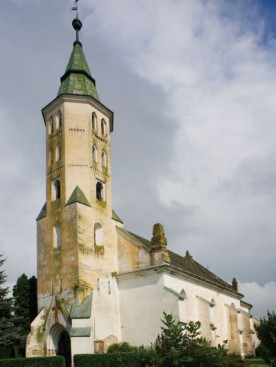Calvinist church in GacsályThe first written mention of the village of Gacsály dates back to 1263. The name originates from the German word “Gottschall” meaning “Servant of God”. The village belonged to the Gacsályi family of the Gutkeled generation. Gacsály’s church is mentioned in a papal tithe list from 1332-1336/1337 as a property within the Ugocsa archdeaconry. The Gutkeled generation was one of the biggest and the earliest church building families. The most important estates of this generation could be found in the Nyírség. The former monastery of Sárvár, which was dedicated to St. Peter, was prominent between the churches, which were raised by this generation. The ruins of the Romanesque monastery, which was built by the Gutkeled generation in the 13th century can be found in the outskirts of the present Nyíradon, in the Gúti forest. This church was consecrated in the honour of the Holy Virgin. The Calvinist church of Gacsály and the Roman Catholic church of Zajta emerge between the churches, that was built by the Gutkeled generation and these are the most beautiful historic monuments of the Erdőhát region in Szatmár. An interesting fact about the church is that its construction can be divided into several separate phases. The first construction phase dates back to the early 14th century. From that period, only the tower and the northern part of the western wall of the nave have been preserved. The tower is six storeys in height, the lower three storeys are square and the upper three are octagonal. In the western wall is an arched door. Attached to the nave of the first church at the east end was a sanctuary which ended in a straight line. Diagonal buttresses enforced the corners of the nave and the sanctuary. During the second construction phase, which dates back to the second half of the 16th century, with the exception of the tower and some parts in the western wall of the nave, the old building, which was already in ruins, was demolished, and a new, longer and wider church building was constructed on the same site. A new nave was constructed and attached to the tower, and a sanctuary was attached to the east end of the nave. The sanctuary featured Gothic vaulting and was divided by a triumphal arch. Buttresses enforced the western corners of the sanctuary and the nave. A square-based vestry was attached to the northern side of the sanctuary. In 1717, Csengersima, Gacsály and the entire county were devastated by the Tatars. The full restoration of the seriously damaged church began in 1734, and was not complete until 1759. The third construction phase dates back to those years. The conditions prevailing at that time are depicted in notes and sketches made by Flóris Rómer in 1864, and in drawings created by Ferenc Schulcz in 1868. The fourth construction phase dates back to the years between 1902 and 1911. The restoration work was performed by the National Heritage Committee which was led by Gyula Forster. The sum of 2000 koronas, which was made available for the restoration work, was not much, but providing a subsidy to restore a not too significant village church was quite rare in those days. Today, the church building shows the results of those restoration activities. The latest restoration activities were implemented between 2013 and 2014. Due to the reconstruction works implemented earlier, introducing the historical details of medieval architecture has only been limitedly possible. In order to restore the original dimensions, the walls have been heightened for the reconstructed roof structure. As part of the process of restoration, the tower and the nave have been completely renewed. New bricks have been laid. Under the western gallery they have been sunken to the original level, and in the nave, they indicate the walls of the old church building. The interior wall surfaces have been rendered in a way that indicates the different construction phases. On the western wall of the church, the western Gothic window has been reconstructed. A late Gothic chapel makes the sanctuary even more beautiful. The total release of the carved medieval stones secondarily built into the walls has not been possible. A few of the stones are exhibited under the gallery.
The painted cassette-style wooden ceiling of the church, which was created in 1759, originally consisted of 172 panels. At present, only 46 panels can be observed. Yes, what we can see in Gacsaly now, is only a small part of a huge ceiling. With its 172 panels, it was the most monumental ceiling in the region, far exceeding in size any other construction of approximately the same age in Csenger, Csengersima and Gyügye. It is probable that without the practice of the official contemporary cultural heritage protection, each part of the wooden ceiling would have totally disappeared. The restoration activities implemented between 1902 and 1911 were only partially able to preserve the wooden ceiling. The ornamental motives appearing on the cassettes display the influence of the Italian Renaissance. The cassette-style ceiling of Gacsály’s church is similar to that of Técső in Subcarpathia, but mainly Sonkád. In the early 20th century, as part of the process of restoration, the preserved cassettes were attached to the restored ceiling of the church. For today’s presentation of the building, the new wooden ceiling not only indicates the old wooden ceiling, but it also allows connection to the original cassettes waiting for restoration. |
















